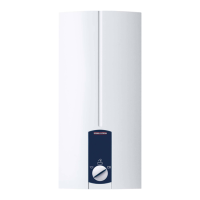WWW.STIEBEL-ELTRON-USA.COM CF SERIES| 25
ENGLISH
INSTALLATION
SPARE PARTS AND SERVICE ADVICE
11. Spare parts and service advice
DANGER: Electrocution
Before proceeding with any installation, adjustment,
alteration, or service of the appliance all circuit break-
er, switches servicing the appliance must be turned off.
Make sure that nobody can activate the breaker in the
distribution panel during your service work on the ap-
pliance.
DANGER: Burns
Water temperatures over 125 °F (52 °C) can cause severe
burns instantly or death from scalding. A scalding poten-
tial risk exists on any connected tap or fixture and on the
surface of the heat exchanger during service.
Before opening the housing for service, ensure the on/off
switch is in the “off” position.
Flush cold water through the heater for several minutes.
The ball valves need to be completely open.
Pressure switch
Check the water supply pressure. The CF requires 3 psi (0.21 bar) to
activate the pressure switch. Check for continuity across the switch
contact. If the switch is not closed and the pressure is more than
3psi (0.21 bar), the mechanical portion of the pressure switch may
clogged with debris.
Thermostat
The thermostat may fail if a large amount of air passes through the
element and the temperature increases to over 260 °F (127 °C) due to
a lack of cooling. The thermostat also has a permanent cut-off safety
function in case of an emergency caused by overheating. The fuse
side of the thermostat will, by design, be destroyed by extreme heat.
Should this occur, the thermostat will need to be replaced.
If the thermostat was not overheated, it will have continuity.
The thermostat condition is determined by a continuity check after
power is off and cold water has been run through the heater to
reset the thermostat.
If the thermostat has no continuity, it should be replaced. Make sure
that the water is drained, and the power supply is off. Remove the
wires to the thermostat with a flathead screwdriver. Remove the Allen
screw with a ¼˝ T-handle Allen wrench. Remove the thermostat and
replace it with an identical spare part item, e.g. L125 T puts out 125 °F
hot water. Do not mix them with any other temperature designated
items. Replace the thermostat clips. Make sure that the concave end
is down to create a tight seal. Reinsert the Allen screws. Reattach the
wire. Make sure that the wire screws are tightened fully.
Element
If the contactor is pulling and there is still lukewarm water at the
desired flow rate, a failed element may be the cause.
f Disconnect the heater from the power supply.
f Check each element with an Ohm meter for correct reading.
See 4.3, “Cold element resistivity by heater type (in Ohms)”, pg.
5 to identify the element resistivity according to the heater
name plate and wattage. If the element reads 0 Ohm or the
meter flickers, the element needs to be replaced.
f For replacing the identified bad element, use a Phillips screw-
driver to remove the wire. If there is more than one failed ele-
ment, mark the wires of the associated elements.
f Close the ball valves and drain the heater.
f To remove the element from the heat exchanger socket, use a
1 ½˝ socket wrench spanner. If the failed element looks like it
is split from the inside, this can be caused by air contamination
during heating.
f Insert the new element, being sure that the replacement ele-
ment has a factory provided O-ring in place.
f Tighten the element. Make sure that it is not overly tight. This
will ruin the O-ring sealing.
f After all element are replaced check for leaks by opening the
ball valves and running water through the heater.
f Reattach the wires to the element.
f Turn on the power supply.
f Turn on the on/off power switch.
Contactor
f Disconnect the heater from the power supply.
f Remove all wires from the contactor.
f Remove the mounting screws on the side of the contactor.
f Replace the contactor with the spare, ensuring that the spare
part matches exactly. The part nomenclature is made from four
parts:
1 Type prefix = MC
2 Motor load AMP a 100 A would be the equivalent of 150 a full
load draw in a resistance heater.
3 120 V AC = 120 V coil voltage. If there is a 208 V application,
coil voltage type needs to be 208 V. For a 240 V application, coil
voltage needs to be 240 V type.
4 Suffix 2 or 22.
f Reconnect the wires to the contactor. Make sure that the wires
match the contactor ports exactly as they were before removal.
Transformer
f Disconnect the heater from the power supply.
f Check for continuity on the fuse FLM1-1/4 to be sure the prob-
lem is not just a transformer fuse.
f Replace wire from the transformer distribution block. Make sure
to mark the wire to the desired port.
f Loosen the mounting screws in the corner of the transformer to
the support bar.

